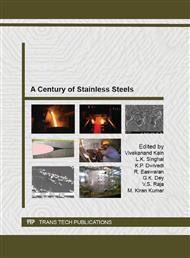p.530
p.539
p.552
p.564
p.575
p.583
p.592
p.598
p.606
Corrosion Resistance of 9 - 15% Cr ODS Steels and its Comparison with Austenitic Stainless Steel
Abstract:
An oxide dispersion strengthened steels are one of the most promising high temperatures, and high performance advanced structural material being developed for future fast reactors and high-temperature Generation IV reactors. In the present work, the corrosion resistance and its correlation with the passive film compositions of 11% Cr F/M and 9-15% Cr (with Zr or Hf) ODS steels is examined and compared with AISI type 304L stainless steel in boiling 60 - 62% (~13 M) HNO3. The corrosion rate measured in 62% HNO3 for 240 h of 11% Cr F/M, 9% Cr and 15% Cr (Zr) ODS steels show high corrosion rate. On the other hand, low corrosion rate was observed in 304L stainless steel (0. 21 to 23 mm y-1). However, severe intergranular corrosion attack was revealed in type 304L SS after 240 h exposure, but none in ODS steels. Such an intergranular corrosion attack seen in type 304L stainless steel is undesirable. On the contrary, low corrosion rate (0.04 0.15 mm y-1) of 15% Cr (Hf) ODS steel in 3 M, 6 M and 9 M HNO3, comparable to that of type 304L stainless steel was observed. The improved corrosion resistance of 15% Cr (Hf) ODS steel was attributed to enrich (20 at. %) and protective Al2O3 layer formation in addition to Cr2O3 in the passive film.
Info:
Periodical:
Pages:
575-582
Citation:
Online since:
September 2013
Authors:
Keywords:
Price:
Сopyright:
© 2013 Trans Tech Publications Ltd. All Rights Reserved
Share:
Citation:


